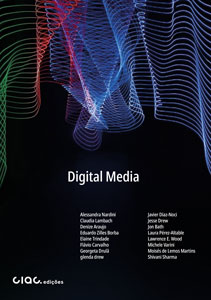The Visual Culture Working Group (VIC) has released two new e-books published by CIAC – Centro de Investigação em Artes e Comunicação. Both volumes reflect VIC’s commitment to exploring the intersections between visuality, technology, and society across global contexts.
 Digital Media
Digital Media
https://ciac.pt/en/publications/digital-media/
Edited by Denize Araujo and Claudia Lambach, the publication features contributions from leading members of VIC. The volume brings together essays that investigate how digital technologies are transforming cultural production and experience worldwide. Topics include the creation and circulation of images, the influence of algorithms on news and audiences, the role of virtual reality in audiovisual practices, and the dynamics of industrial production and multicultural globalization.
With contributions by Alessandra Nardini, Claudia Lambach, Denize Araujo, Eduardo Zilles Borba, Elaine Trindade, Flávio Carvalho, Georgeta Drulă, glenda drew, Javier Díaz-Noci, Jesse Drew, Jon Bath, Laura Pérez-Altable, Lawrence E. Wood, Michele Varini, Moisés de Lemos Martins, and Shivani Sharma, the 210-page book (ISBN 978-989-9127-71-5) highlights diverse approaches to digital culture and suggests new directions for research and debate.
Arts, Concepts and Technologies in Visual Culture
 Edited by Denize Araujo, Chair of the Visual Culture Working Group, the publication was launched on 16 July 2025 during the IAMCR International Conference at Nanyang Technological University, Singapore. The e-book gathers authors from eight countries—Brazil, Germany, India, Italy, Portugal, Spain, the United States, and Uruguay—who reflect on the dialogue between arts, concepts, and technologies in visual culture.
Edited by Denize Araujo, Chair of the Visual Culture Working Group, the publication was launched on 16 July 2025 during the IAMCR International Conference at Nanyang Technological University, Singapore. The e-book gathers authors from eight countries—Brazil, Germany, India, Italy, Portugal, Spain, the United States, and Uruguay—who reflect on the dialogue between arts, concepts, and technologies in visual culture.
Contributors include Ana Sedeño, Denize Araujo, Fernando Andacht, Govind Pandey, Michele Varini, Paulo Filipe Monteiro, Susan Keith, and Thomas Wiedemann. The texts, written in English, French, and Spanish, offer cross-cultural perspectives on artistic creation and digital transformation.
Together, these publications illuminate how visual culture scholars around the world are rethinking art, technology, and media in the digital age.